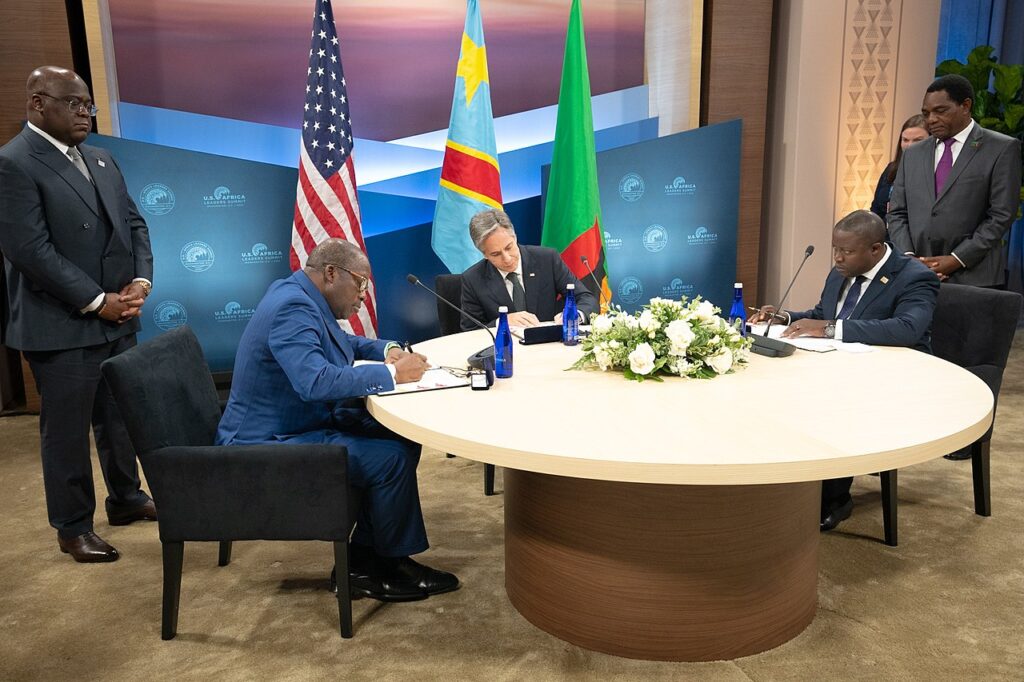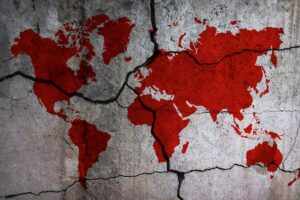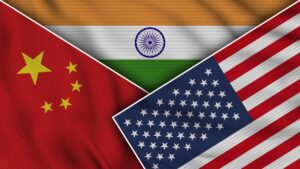US Involvement in the Lobito Corridor Project
At last year’s Group of Seven Summit in Japan, U.S. President Joe Biden announced a $250-million investment plan to rehabilitate the Lobito Corridor — part of an ambitious multilateral plan to connect the Democratic Republic of Congo (DRC) and Zambia to European and North American markets via the Port of Lobito in Angola. The project is intended to upgrade one railway and build a new one that will result in “the first trans-African rail line, stretching from the Atlantic Ocean to the Indian Ocean.” U.S. officials have labeled the Lobito Corridor project as a symbol of Washington’s effort to enhance continental integration, increase exports and regional trade, and boost economic growth and job creation across Africa. The project, backed by the European Union (EU), is the first of its kind under the G-7’s PGII.
US-China Rivalry in Africa
Perhaps unsurprisingly, U.S. support for the Lobito Corridor project has geopolitical implications.
Many commentators have framed the project as Washington’s answer to China’s Belt and Road Initiative (BRI). As geopolitical rivalry intensifies among the world’s great powers amid the ongoing global transition from fossil fuels to clean energy sources, critical minerals are bringing new dimensions to energy security. For the United States and the EU, connecting the Central African Copper Belt ― a large, copper-rich area comprising part of the DRC and Zambia ― to the Atlantic Ocean is a means of reducing the West’s dependence on China for key minerals used in the production of consumer goods and military technologies. Thus, the involvement of the United States and its European allies in the Lobito Corridor project indicates Washington’s increasing willingness to use great power competition as an organizing framework for foreign policy. That, in turn, raises many questions about the efficacy and viability of the “equal partnership” the Biden administration has articulated as part of its much-touted “reset” of relations with African countries.
Dating back many years, U.S. officials have regularly criticized Beijing’s investment in Africa as predatory — causing debt traps and lacking transparency — as well as exacerbating corruption, environmental degradation, and poor governance. The Biden administration has advertised the Lobito Corridor project as an alternative model of cooperation for African countries, one that it argues leverages Washington’s ability to mobilize private capital to invest in infrastructure as well as other key areas like digital technology, climate change mitigation, and energy security. During a recent four-nation African tour that included a stop in Angola, U.S. Secretary of State Antony Blinken highlighted the Lobito Corridor project as a “genuinely transformative” example of the “long-term sustainable production” that he argued Washington is supporting across Africa. But, on closer inspection, the new U.S. approach mostly mimics China’s line of action and prioritizes Washington’s geopolitical objectives ahead of Africa’s sustainable development goals. As currently designed, the Lobito Corridor project will most likely exacerbate existing environmental and human rights crises in the subregion and undermine the sustainable development goals of its target countries. By choosing a framework of competition — instead of cooperation — with China across Africa, the United States is duplicating efforts that could and should be channeled toward other areas that would better enable governments across the continent to deliver on their social development objectives.
Rail Competition
In seeking to become the continent’s partner of choice amid the race to secure the critical minerals needed to power the green energy revolution, the United States and its European allies have committed funding for the existing 1,300-kilometer Lobito Atlantic Railway connecting Angola, Zambia, and the DRC, as well as a new rail line that will connect Angola and Zambia. Taken together, these projects represent Washington’s largest railway investment in Africa in many decades, a point the Biden administration has regularly underscored in public engagements. But the two projects will significantly overlap with the so-called Benguela corridor, which was built during the colonial era and reconstructed from 2006 through 2014 by the China Railway Construction Corporation Limited(CRCC) after it was destroyed during the Angolan Civil War. In addition, the CRCC was recently awarded the concession to revamp the Tanzania-Zambia railway, which connects the Zambian Copper Belt to the port of Dar Es Salaam in Tanzania. U.S. officials, who readily acknowledge that Washington has typically steered clear of infrastructure investments in developing countries, now quietly concede that the United States has little choice but to “compete” against China’s enormous track record of investments in Africa.
But matching Beijing’s footprint will be easier said than done. The BRI is the world’s largest-ever global infrastructure initiative, totaling more than $1 trillion. Under the initiative, China has financed and built roads, power plants, ports, railways, and digital infrastructure around the world. Nearly 150 countries have signed on to the BRI in some form, including a reported 53 of the African Union’s 55 member states. According to Boston University’s Chinese Loans to Africa Database, China provided more than $170 billion to African countries and regional organizations from 2000 through 2022. Many of those investments have come under considerable scrutiny, and China’s investment on the continent is believed to be shifting the number as well as the nature of investments, contracts, and projects. Nonetheless, Beijing’s extensive footprint across Africa, as well as investments by Chinese firms, has enabled China to build deep, comprehensive partnerships including over the critical minerals that have now become an object of geopolitical competition. Washington has a lot of ground to make up, and, given the vast differences between the United States and China — including their dissimilar systems of government, economies, and strategic priorities — Washington is unlikely to match Beijing’s investment in Africa at the same scale. Aside from the question of the United States’ ability to follow through on its pledges, Washington’s attempt to borrow a page from Beijing’s book could prove to be a day late and a dollar short at a time when the nature of the relationship between Beijing and African capitals is changing.
In recent years, for example, the infrastructure-led growth model that has driven the partnership between African countries and China to unprecedented heights has come into question. Some African observers argue that infrastructural megaprojects — including highways, bridges, railways, power stations, and airports — have not spurred the growth and industrialization that African countries need, but rather have worsened their debt profiles. These critics advocate for a shift toward agriculture-led growth that would leverage the continent’s abundance of land and potential for high returns on investment in the sector. Whether African governments will adopt this shift en masse remains to be seen, but China is increasingly moving away from funding big infrastructure and energy projects on the continent. In that vein, Washington’s push for infrastructural investment in a geopolitically important part of central and southern Africa appears belated, reactive, narrowly conceived, and insufficiently cognizant of debates and trends across the continent more broadly.
The Rush for Critical Minerals
Contrary to what the United States and its European allies purport, the Lobito Project does not depart from traditional extractivism — the removal of large quantities of natural resources with minimal processing, for the purpose of exporting — programs in the Global South. The implications of the project for the environment and climate are considerable, given the negative impact of the extraction of critical minerals on communities, the environment, and security. One report by the United Nations argued that the global extraction of raw materials will increase by 60% by 2060, with devastating consequences. In Zambia, some of the long-term impacts of mining and ore processing in the country’s Copper Belt include deforestation; the contamination of water, soil, and crops; air pollution; and loss of wildlife. In the DRC, nearly 10% of the country’s tree cover has been lost since 2000, and coltan extraction1 As the Institute for Security Studies notes, “Coltan is one of the world’s most vital minerals, and 60% of reserves globally are found in the Democratic Republic of the Congo’s (DRC) Kivu province. The mineral is used in cell phones, laptops and other devices because of its particular ability to store and release electrical energy.” Institute for Security Studies. has been identified as a major driver of deforestation. Environmental degradation and human rights abuses linked to mining in the country are widespread, and the exploitation of minerals by foreign corporations in eastern DRC is a significant driver of the conflict there. U.S. officials have argued that the U.S. model of economic partnership in Africa maintains strong governance, labor, and environmental standards, but there are ample reasons to be skeptical of that claim given the disconnect between Washington’s public rhetoric and its policies.
In theory, the rush for critical minerals should be a boon for mineral-rich African countries like Zambia and the DRC. In practice, however, the windfalls are likely to be limited given that African minerals are mostly exported in their raw states and refined abroad. For instance, China reportedly accounts for 85% of global processing capacity and 60% of worldwide production of critical minerals. By comparison, the DRC refines about 7% of all copper products produced locally while Zambia refines 1.3%. In February 2024, a group of African countries presented a resolution at the U.N. Environment Assembly calling for equitable benefit-sharing from extraction. As the demand for the continent’s minerals intensifies, attention is increasingly turning to ways African countries can capitalize on their mineral endowments to drive sustainable growth, industrialization, and development through value-added processing and manufacturing. Currently, there is little in the framework of the Lobito Corridor project that significantly boosts any of these objectives, and any hopes of doing so are aspirational at best. Given that realization, the Lobito Corridor is more likely to mirror the imbalanced nature of previous rounds of resource extraction, which in turn would undermine the grand objectives the United States and its European allies have staked out as part of the PGII.
Geopolitical Benefits
Washington’s enthusiasm for the Lobito Corridor project speaks to the immense geopolitical benefits U.S. officials believe the project will deliver over time. Key to that effort should be a reorientation away from a counterproductive framing of great power competition and toward cooperation — even with China where possible — and engagement with African nations on their own terms. The United States should work with continental governments as well as the African Union and African regional institutions to optimize value from their mineral endowments; better integrate them into regional and global trade; and build a diverse, resilient, and sustainable supply of critical minerals for the global clean energy transition. Leveraging cooperation via continental and regional frameworks like the African Continental Free Trade Area and the Africa Mining Vision should be prioritized as a means of understanding the interests and priorities of African governments as well as private sector entities, civil society, and community groups. Only by pursuing a holistic approach to building “strategic economic corridors” across Africa will the United States spur innovation, economic growth, and sustainable development across the continent.
Chris O. Ògúnmọ́dẹdé is an editor, consultant, and analyst of African politics, security, and international relations with a specialized focus on West Africa. He has worked with governments, multilateral organizations, foundations, think tanks, corporations, and media organizations. Chris is the author of Penkelemesi, a Substack newsletter about African affairs.
Notes
- 1As the Institute for Security Studies notes, “Coltan is one of the world’s most vital minerals, and 60% of reserves globally are found in the Democratic Republic of the Congo’s (DRC) Kivu province. The mineral is used in cell phones, laptops and other devices because of its particular ability to store and release electrical energy.” Institute for Security Studies.




